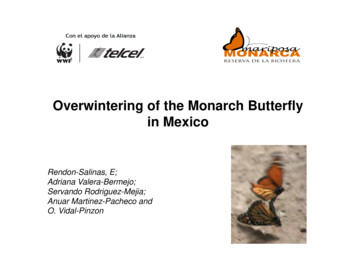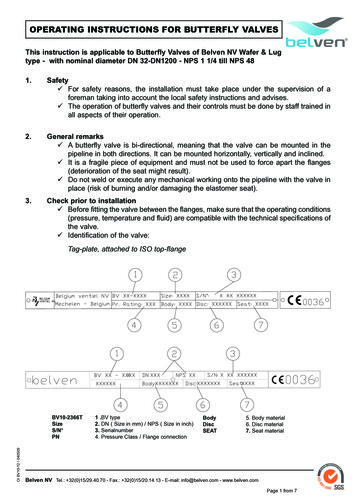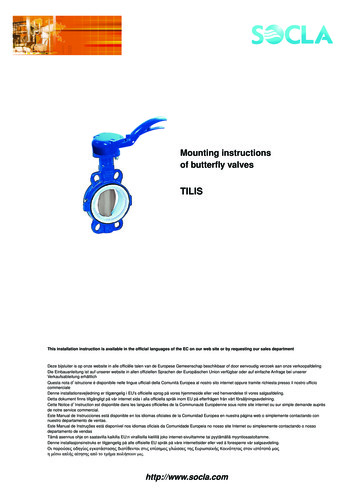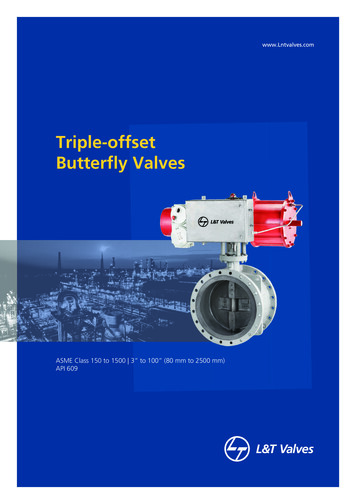
Transcription
Overwintering of the Monarch Butterflyin MexicoRendon-Salinas, E;Adriana Valera-Bermejo;Servando Rodriguez-Mejia;Anuar Martinez-Pacheco andO. Vidal-Pinzon
Introduction: The Monarch Region and the Reserve
Introduction: Conservation of the Monarch Habitat
Cerro AltamiranoIntroductionSierra Chincua Two statesMichoacan 10 municipalities 100 agrarian properties Ejidos Indigenous communities Small private propertiesCore zone:13,551.5 haBuffer zone:42,707.5 haStateof MexicoSierraCampanarioChivatí-HuacalLomas de AparicioCerro Pelon
ObjectivesDeterminate the forest surface occupied by colonies inMexico to establish the annual size of the eastern Monarchpopulation.Determinate the total forest surface occupied by butterfliescolonies in Mexico to establish the priority habitat.
Method: colonies localization and measurementTime 1Time 2a. Azimut angleb. Distance betwentreesaNbb
Method: map and estimation of surface occupied2nd two weeks of november 20081st two weeks of december 20082nd two weeks of december 20081st two weeks of january 20092nd two weeks of january 20091st two weeks of february 20092nd two weeks of february 20091st two weeks of march 2009El Rosario, 2008-2009,Michoacan
Result (1): The size of the Monarch population2018.1818Surface occupied 0072007200820082009200920102010201120112012
Result (2): The total surface of forest occupiedEl Rosario, 2008-2009,Michoacan
Result (2): The total surface of forest occupiedCerro Altamirano
Result (2): The total surface of forest occupiedSierra ChincuaSierra Campanario
Result (2): The total surface of forest occupiedChivatí-HuacalLomas de AparicioCerro Pelón
Result (2): The total surface of forest occupiedLocationStateState ofMexicoInside the ReserveMichoacanSanctuaryCerro Pelón*Michoacan2.1847.205E. La Mesa3.672Cerro AltamiranoCerro Pelón*Chivati-HuacalSierra CampanarioΩE. ContepecE. Nicolás RomeroC. I. CarpinterosE. El RosarioE. Cerro PrietoE. El Calabozo Fracción 1E. Crescencio MoralesTotalSan Mateo AlmomoloaSan Francisco OxtotilpanSan Antonio AlbarranesSan AndresRio de 0256.4691.1375.0522.291.89916.847Lomas de AparicioOutside of the ReserveSurface (ha)2004-201210.036Sierra CampanarioΩSierra ChincuaState ofMexicoColonies (AgrarianProperties)E. El CapulínE. Mesas Altas deXoconuscoC. I. San Juan XoconuscoPiedra HerradaCerro del AmparoPalomasLos AzufresCerro Garnica
Conclusions:1. We must continue with the monitoring program for the overwintering Monarchs inMexico2. We have a real big problem with the declining of Monarch population,3. In the Monarch Reserve; We have a real important information about the habitatuse by Monarchs and we re going to use that to conform the next ManagementPlan,4. We need connect all monitoring programs to have a integrated analysis and pointof view,5. WE NEED TO INCLUDES IN OUR PROGRAMS THE ADAPTATIOS TOCLIMATE CHANGE ,“THE CLIMATE CHANGE IS NOT AFECTING ONLY TO THE MONARCHS, IT’SAFECTING TO US “THE HUMAN BEING”
Thanks!
E. Cerro Prieto 17.022 E. El Calabozo Fracción 1 3.279 Lomas de Aparicio E. Crescencio Morales 1.89 Total 85.025 Outside of the Reserve State of Mexico Piedra Herrada San Mateo Almomoloa 6.469 Cerro del Amparo San Francisco Oxtotilpan 1.137 Palomas San Antonio Albarranes 5.052 Michoacan Los Azufres San Andres 2.29 Cerro Garnica Rio de Parras 1 .











